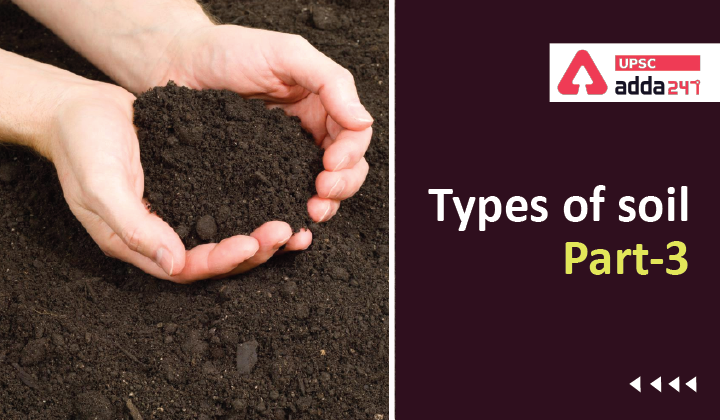Table of Contents
Types of soil in India
Soil is the mixture of rock debris and organic materials which develop on the earth’s surface. However, whole of the soil is not same and differs in its constituents. In the previous article, we have discussed the different layers of soil. In the first article, we discussed about alluvial soil and black soil. In the second article, we discussed about red soil, laterite soil and forest soil. In this article, we will discuss about Arid or Desert Soil, Saline and Alkaline Soil and the Peaty, and Marshy Soil/Bog Soil.
Arid or Desert Soil
- Most of the desert soils consist of Aeolian sand—desert sand under the influence of wind—(90 to 95 per cent) and clay (5 to 10 per cent).
- Arid soils range from red to brown in colour.
- In some areas, the salt content is so high that common salt is obtained by evaporating the saline water.
- Due to the dry climate, high temperature and accelerated evaporation, they lack moisture and humus.
- Soil growth is inhibited by the presence of soil.
- Lower horizons of the soil are occupied by‘kankar’ layers because of the increasing calcium content downwards.
- The ‘Kankar’ layer formation in the bottom horizons restricts the infiltration of water, and as such when irrigation is made available, the soil moisture is readily available for a sustainable plant growth.
Distribution of arid soils
- Desert soils are found in western Rajasthan, Rann of Kachchh, in patches in south Haryana and south Punjab.
- In the coastal regions of Odisha, Tamil Nadu and Kerala, sandy soils without clay factor are also common.
Chemical properties of arid soil
- These soils are poor and contain little humus and organic matter.
- Nitrogen is insufficient and the phosphate content is normal.
- Some desert soils are alkaline with varying degree of soluble salts like calcium carbonate.
Crops of arid soil
- Phosphates and nitrates make arid soil fertile wherever moisture is available.
- Soil reclamation can be done by providing sufficient irrigation.
- These types of soils support the cultivation of the drought resistant and salt tolerant crops such as barley, cotton, millets, maize and pulses.
Alkaline or saline soil
- Alkaline or saline soil are also called Reh, Usar, Kallar, Rakar, Thur, and Chopan.
- The soil lacks in moisture, humus, and living microorganisms, due to which humus formation is almost absent.
- Saline or alkaline soil is mostly infertile.
- They have more salts, largely because of dry climate and poor drainage.
- They occur in arid and semi-arid regions, and in waterlogged and swampy areas. Their structure ranges from sandy to loamy.
Chemical composition of alkaline soil
- These soil lack in nitrogen and calcium.
- Sodium chloride and sodium sulphate are present in alkaline soil, which makes the soil suitable for leguminous crops.
- On weathering, undecomposed rock fragments give rise to sodium, magnesium and calcium salts and sulphurous acid.
Distribution of alkaline soil
- Saline soils are more widespread in western Gujarat, deltas of the eastern coast and in Sunderban areas of West Bengal.
- In the Rann of Kuchchh, the Southwest Monsoon brings salt particles and deposits there as a crust.
- Natural reason: Seawater intrusions in the deltas promote the occurrence of saline soils.
- Man-made reasons: In the areas of intensive cultivation with excessive use of irrigation, especially in areas of green revolution, the fertile alluvial soils are becoming saline.
- Excessive irrigation with dry climatic conditions promotes capillary action, which results in the deposition of salt on the top layer of the soil.
- In such areas, especially in Punjab and Haryana, farmers are advised to add gypsum to solve the problem of salinity in the soil.
Peaty, and Marshy Soil/Bog Soil
- They are found in the areas of heavy rainfall and high humidity, where there is a good growth of vegetation.
- Thus, large quantity of dead organic matter accumulates in these areas, and this gives a rich humus and organic content to the soil
- Organic matter in these soils may go even up to 40-50 per cent.
- These soils are normally heavy and black in colour.
Distribution of peaty soil
- Peaty soil occurs widely in the northern part of Bihar, southern part of Uttarakhand and the coastal areas of West Bengal, Odisha and Tamil Nadu.
- They are also found at the deltaic region of India.
- In Alleppey, Kerala, this soil is known as Karri along the backwaters or Kayals of Kerala
Chemical composition of peaty soil
- These soils are deficient in potash and phosphate.
- More content of salt and every day inundation by high tide makes the soil infertile.
Crops in peaty soil
- Peaty soil supports the cultivation of paddy, as soon as rainfall ceases.
- Over the Bengal delta, it is suitable for jute and rice, and over Malabar region, it is suitable for spices, rubber, and rice.
Geography notes for UPSC





 TSPSC Group 1 Question Paper 2024, Downl...
TSPSC Group 1 Question Paper 2024, Downl...
 TSPSC Group 1 Answer key 2024 Out, Downl...
TSPSC Group 1 Answer key 2024 Out, Downl...
 UPSC Prelims 2024 Question Paper, Downlo...
UPSC Prelims 2024 Question Paper, Downlo...





